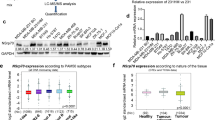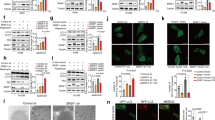Abstract
KH-type splicing regulatory protein (KHSRP) is a multifunctional RNA-binding protein that has a role in tumorigenesis of small cell lung cancer. The KHSRP protein level was shown to be significantly increased in small cell lung cancer (SCLC) tumor tissues compared with normal lung tissues by immunohistochemical staining. Moreover, KHSRP protein levels were strongly associated with T stage in patients with SCLC. Using in vitro assays, we found that knockdown of the KHSRP gene inhibited cell proliferation and increased cell apoptosis but had no effect on cell migration and invasion. We also showed that down-regulation of the KHSRP gene suppressed tumor growth in vivo. Further analyses indicated that KHSRP was involved in miR-26a maturation and inhibited the expression of PTEN in SCLC cells. Taken together, these findings suggested that KHSRP plays an important role in SCLC tumorigenesis and could be a potential novel therapeutic target for SCLC treatment.






Similar content being viewed by others
Abbreviations
- KHSRP:
-
KH-type splicing regulatory protein
- SCLC:
-
Small cell lung cancer
- PTEN:
-
Phosphatase and tensin homolog deleted on chromosome ten
- qRT-PCR:
-
Quantitative real-time polymerase chain reaction
- FBS:
-
Fetal bovine serum
- CCK-8:
-
Cell Counting Kit-8
- PBS:
-
Phosphate-buffered saline solution
- SD:
-
Standard deviation
References
Sorensen M, Pijls-Johannesma M, Felip E (2010) Small-cell lung cancer: ESMO Clinical Practice Guidelines for diagnosis, treatment and follow-up. Ann Oncol 21(Suppl 5):v120–v125
Johnson BE, Grayson J, Makuch RW, Linnoila RI, Anderson MJ, Cohen MH et al (1990) Ten-year survival of patients with small-cell lung cancer treated with combination chemotherapy with or without irradiation. J Clin Oncol 8:396–401
Briata P, Bordo D, Puppo M, Gorlero F, Rossi M, Perrone-Bizzozero N et al (2016) Diverse roles of the nucleic acid-binding protein KHSRP in cell differentiation and disease. Wiley Interdiscip Rev RNA 7(2):227–240
Winzen R, Thakur BK, Dittrich-Breiholz O, Shah M, Redich N, Dhamija S et al (2007) Functional analysis of KSRP interaction with the AU-rich element of interleukin-8 and identification of inflammatory mRNA targets. Mol Cell Biol 27:8388–8400
Lin WJ, Zheng X, Lin CC, Tsao J, Zhu X, Cody JJ et al (2011) Posttranscriptional control of type I interferon genes by KSRP in the innate immune response against viral infection. Mol Cell Biol 31:3196–3207
Bird CW, Gardiner AS, Bolognani F, Tanner DC, Chen CY, Lin WJ et al (2013) KSRP modulation of GAP-43 mRNA stability restricts axonal outgrowth in embryonic hippocampal neurons. PLoS One 8:e79255
Chou CF, Zhu X, Lin YY, Gamble KL, Garvey WT, Chen CY (2015) KSRP is critical in governing hepatic lipid metabolism through controlling Per2 expression. J Lipid Res 56:227–240
Lin YY, Chou CF, Giovarelli M, Briata P, Gherzi R, Chen CY (2014) KSRP and MicroRNA 145 are negative regulators of lipolysis in white adipose tissue. Mol Cell Biol 34:2339–2349
Santarosa M, Del CL, Viel A, Bivi N, D’Ambrosio C, Scaloni A et al (2010) BRCA1 modulates the expression of hnRNPA2B1 and KHSRP. Cell Cycle 9:4666–4673
Malz M, Weber A, Singer S, Riehmer V, Bissinger M, Riener MO et al (2009) Overexpression of far upstream element binding proteins: a mechanism regulating proliferation and migration in liver cancer cells. Hepatology 50:1130–1139
Yang J, Fan J, Li Y, Li F, Chen P, Fan Y et al (2013) Genome-wide RNAi screening identifies genes inhibiting the migration of glioblastoma cells. PLoS One 8:e61915
Bikkavilli RK, Malbon CC (2010) Dishevelled-KSRP complex regulates Wnt signaling through post-transcriptional stabilization of beta-catenin mRNA. J Cell Sci 123:1352–1362
Rudin CM, Durinck S, Stawiski EW, Poirier JT, Modrusan Z, Shames DS et al (2012) Comprehensive genomic analysis identifies SOX2 as a frequently amplified gene in small-cell lung cancer. Nat Genet 44:1111–1116
Gonzalez-Perez A, Perez-Llamas C, Deu-Pons J, Tamborero D, Schroeder MP, Jene-Sanz A et al (2013) IntOGen-mutations identifies cancer drivers across tumor types. Nat Methods 10:1081–1082
Guo L, Liu Y, Bai Y, Sun Y, Xiao F, Guo Y (2010) Gene expression profiling of drug-resistant small cell lung cancer cells by combining microRNA and cDNA expression analysis. Eur J Cancer 46:1692–1702
Wei T, Liu Q, He F, Zhu W, Hu L, Guo L et al (2012) The role of N-acetylglucosaminyltransferases V in the malignancy of human hepatocellular carcinoma. Exp Mol Pathol 93:8–17
Wistuba II, Gazdar AF, Minna JD (2001) Molecular genetics of small cell lung carcinoma. Semin Oncol 28:3–13
Yokomizo A, Tindall DJ, Drabkin H, Gemmill R, Franklin W, Yang P et al (1998) PTEN/MMAC1 mutations identified in small cell, but not in non-small cell lung cancers. Oncogene 17:475–479
Tatematsu A, Shimizu J, Murakami Y, Horio Y, Nakamura S, Hida T et al (2008) Epidermal growth factor receptor mutations in small cell lung cancer. Clin Cancer Res 14:6092–6096
Shibata T, Kokubu A, Tsuta K, Hirohashi S (2009) Oncogenic mutation of PIK3CA in small cell lung carcinoma: a potential therapeutic target pathway for chemotherapy-resistant lung cancer. Cancer Lett 283:203–211
Gherzi R, Chen CY, Trabucchi M, Ramos A, Briata P (2010) The role of KSRP in mRNA decay and microRNA precursor maturation. Wiley Interdiscip Rev RNA 1:230–239
Huse JT, Brennan C, Hambardzumyan D, Wee B, Pena J, Rouhanifard SH et al (2009) The PTEN-regulating microRNA miR-26a is amplified in high-grade glioma and facilitates gliomagenesis in vivo. Genes Dev 23:1327–1337
Fkih MI, Privat M, Ponelle F, Penault-Llorca F, Kenani A, Bignon YJ (2015) Identification of miR-10b, miR-26a, miR-146a and miR-153 as potential triple-negative breast cancer biomarkers. Cell Oncol (Dordr) 38:433–442
Lee DH, Forscher C, Di Vizio D, Koeffler HP (2015) Induction of p53-independent apoptosis by ectopic expression of HOXA5 in human liposarcomas. Sci Rep 5:12580
Lee DH, Amanat S, Goff C, Weiss LM, Said JW, Doan NB et al (2013) Overexpression of miR-26a-2 in human liposarcoma is correlated with poor patient survival. Oncogenesis 2:e47
Trabucchi M, Briata P, Garcia-Mayoral M, Haase AD, Filipowicz W, Ramos A et al (2009) The RNA-binding protein KSRP promotes the biogenesis of a subset of microRNAs. Nature 459:1010–1014
Perez-Ramirez C, Canadas-Garre M, Molina MA, Faus-Dader MJ, Calleja-Hernandez MA (2015) PTEN and PI3K/AKT in non-small-cell lung cancer. Pharmacogenomics 16:1843–1862
Luzi E, Marini F, Sala SC, Tognarini I, Galli G, Brandi ML (2008) Osteogenic differentiation of human adipose tissue-derived stem cells is modulated by the miR-26a targeting of the SMAD1 transcription factor. J Bone Miner Res 23:287–295
Carracedo A, Alimonti A, Pandolfi PP (2011) PTEN level in tumor suppression: how much is too little? Cancer Res 71:629–633
Liu B, Wu X, Liu B, Wang C, Liu Y, Zhou Q et al (2012) MiR-26a enhances metastasis potential of lung cancer cells via AKT pathway by targeting PTEN. Biochim Biophys Acta 1822:1692–1704
Acknowledgments
The authors thank Miaojuan Huang for her helpful advice on this article.
Author contributions
Jian Zhang and Linlang Guo designed this study. Lihua Tong and Yingshan Luo performed the experiments. Ting Wei and Haihong Wang provided helpful suggestions on the manuscript. Experiments were performed under the supervision of Jian Zhang and Weiliang Zhu. Lihua Tong wrote the manuscript.
Funding
This research was supported by the Natural Science Foundation of Guangdong Province (2016A030313632) and the National Natural Science Foundation of China (81302031).
Author information
Authors and Affiliations
Corresponding authors
Ethics declarations
Conflict of Interest
The authors declare no conflict of interest.
Ethical approval
All procedures involving human participants were in accordance with the ethical standards of the institutional and national research committee and with the 1964 Declaration of Helsinki and its later amendments or comparable ethical standards. All procedures involving animals were in accordance with the ethical standards of the institution or practice at which the studies were conducted.
Informed consent
Informed consent was obtained from all individual participants included in the study.
Rights and permissions
About this article
Cite this article
Tong, L., Luo, Y., Wei, T. et al. KH-type splicing regulatory protein (KHSRP) contributes to tumorigenesis by promoting miR-26a maturation in small cell lung cancer. Mol Cell Biochem 422, 61–74 (2016). https://doi.org/10.1007/s11010-016-2806-y
Received:
Accepted:
Published:
Issue Date:
DOI: https://doi.org/10.1007/s11010-016-2806-y




